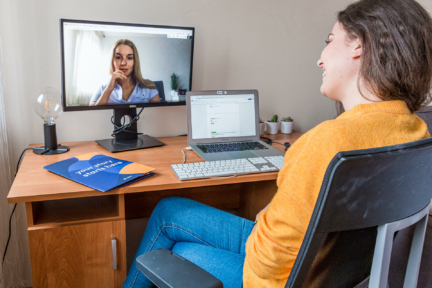Nowadays, new technologies enable remote collaboration and streamline processes across all industries. Remote work isn’t a novelty anymore, especially among software services companies. But, from a business perspective, it might be challenging to develop software fully remotely. When looking for the best off-site software house, you might have some doubts and questions about how remote software development looks like. Read on to find out how Miquido is handling this process and why it can be beneficial for your business.
Why is it worth developing software remotely?
Well, there are two sides to every coin. Some professionals prefer to collaborate face to face and they are more trusting of stakeholders once they can meet. Nevertheless, this traditional approach is becoming obsolete and unfavourable in many situations.
On the other hand, remote collaboration on software development can be convenient for many businesses. At Miquido, we proceed with most of our projects remotely, because the vast majority of our clients are from abroad.
Work with the exceptional remote developers
Remote software development certainly creates more opportunities, since you can hire a team from all over the world. Find the best service provider without limiting yourself when it comes to locality. Even the most comprehensive and sophisticated solutions can be created anywhere in the world. To do so, you need to team up with world-class professionals and use the right online collaboration tools.
Save time
Even if you’re living in the same country as the software house, you can still spend a lot of time on transportation, not to mention commuting expenses. Moreover, online meetings can be shorter than in-person ones. They can also be more efficient and deliberate due to their stringent form. Regular communication is a must-have for the seamless collaboration when a customer’s decisions are crucial. Some forms of online collaboration are mandatory in almost every case.
How to develop software remotely?
Actually, almost all of Miquido’s projects were developed fully remotely. We’ve worked on more than 100 digital products with clients located abroad. Over the years, we’ve mastered long-distance collaboration with customers from different continents. Thus, we’ve faced the challenge of working with clients living in different time zones. We’ve gained lots of experience in our field and we’re happy to share our approach to software development.
To start developing software remotely with Miquido, you don’t need any specific documentation, knowledge about technology or methodology. We’ll guide you through the whole process so that you only need to have your business goals in mind, and we’ll take care of the rest.
Online meetings
Project kick-off
We organise remote workshops to align the vision across all participants. Such meetings can help potential customers make the final decision regarding our cooperation. Thanks to the series of goal-oriented exercises, we can jointly find answers to all product-related questions.
For further collaboration, it’s vital to evaluate a business idea, determine a prototype creation or redefine the product’s scope. Based on gathered information, we can establish milestones such as MVP release.
Once a client decides to cooperate with us, we set up a kick-off meeting dedicated to every person involved in the project. That way, we can discuss project roles and present definitions that we’ll use, as well as meet each other.
As a result of a kick-off meeting, we create a roadmap, set up a timeline and priorities, as well as choose which features we should implement first. In conclusion, customers will know when to expect an MVP and the next releases of their products.
Design studio workshops
These online meetings are conducted to learn about end-users’ preferences and customer’s requirements regarding UX and UI. During such workshops, we want to find out what the business goals and usability concept of a product are.
We’re flexible, so we can video call you and your team anytime. We’re based in Poland, but we can abide by your schedule regardless of time zones.
Communication and project management
During the remote software development process, seamless communication is the key to success. We suggest meeting online at least once a week for an update regarding projects. Some of our customers are willing to engage in the process every day. We’re happy to include clients in our daily stand-ups for more effective cooperation, if they wish.
We’re flexible when it comes to choosing communication channels, and we’re glad to join our client on Slack, Hangouts or Skype. Once, we even created a dedicated voice assistant for running discovery workshops! We designed and developed a workshop tool that was adjusted to the product’s specific requirements. Learn more about that solution here: Ok, Google! Define yourself!
When it comes to project management, we’re using Jira and Confluence. Our clients have access to these tools so that they are able to track our performance and check out new changes, as well as make sure there are no delays. We upload comprehensive documentation in Jira and Confluence. That includes roadmaps, graphic designs, technical requirements and summaries of the video conferences.
Moreover, as we encourage our clients not only to review our progress but also to contribute to the documentation. That way, we can work together, in spite of the distance.
Roles in a remote project team
Product owner
A product owner is a contact person on the client’s side, who should have a clear vision of a project and who can engage in the software development process. A product owner prioritises backlogs, approves functionalities and answers our questions about the occurring issues. If there’s no such position in your company — you can designate a person in your team who’ll be decisive and take over the role of product owner in the project. We don’t require any technical knowledge from a product owner, just the ability to make the decisions based on your business goals.
Project Manager
On the software house side, a key person is the Project Manager (PM) who’s responsible for our team’s performance. PM organises the team’s workflow and adjusts the plan during the software development according to any changes that may occur over time. A PM’s essential responsibilities include controlling the budget, scheduling meetings, and providing progress updates.
After consulting with a customer, the Project Manager can also take over some of the decision making. PM can become a Scrum Master or a Proxy Product Owner, depending on the chosen framework. Still, a client always has full control over a project.
UX/UI team
A team of user experience (UX) and user interface (UI) designers is responsible for creating a product design. Our designers focus on the visual concept of a solution and the experience of the end-users. Their aim is to deliver the most intuitive, functional and aesthetic interface possible. They can also help in defining personas, creating a project mind map, and preparing UX/UI workshops. We help to implement readymade designs for some of our customers, but even in such cases, we’re happy to change designs if necessary. Our UX/UI team makes sure that the graphic project is deployed appropriately and that the design is coherent across all platforms.
Developers
A team of experienced professionals who can develop high-quality software based on client’s requirements. With over ten years of experience and all-in approach, we’re ready to help our customers in developing, launching and supporting the best digital products.
Developers take an active part in the whole software development process, and they’re available for customers to contact too. We believe it’s vital for our cooperation if you meet everyone who is involved in a project, not only the PM.
Very often, we work on projects on a long-term basis in order to support our apps. In such cases, we provide a group of developers who are responsible for maintenance.
QA team
To meet customer expectations, the team of developers includes quality assurance experts. They are responsible for preparing and realising a Test Plan.
Our QA team makes sure that a digital project delivered by Miquido is top-notch. We’re testing performance by determining the speed, responsiveness and stability of applications and devices under a workload. The QA team is also focusing on testing widgets, integrations, usability and security. We’re validating flow of user journeys in the app and ensuring the data integrity between various system components and systems.
Moreover, when it’s possible, we’re automating the testing process. Test automation framework is a separate software solution that is repetitively comparing the current outcome against the predicted outcome. Such an approach can save us a lot of time on manual testing, and so, speed up the software development process.
Agile methodology in remote software development
Based on our vast experience in the field, we choose to use an Agile Framework such as Scrum or Kanban. Among the most significant advantages of working with this prominent methodology are responsiveness, creativity, flexibility and transparency. Early identification and resolution of issues, iterative releases, early delivery and predictable costs all contribute to high productivity and fast software development.
Rumour has it that creating a digital product remotely can take longer than making one conventionally. Our successful remote projects prove this myth wrong. The agile methodology enables us to deliver a prototype in two weeks, and a minimum viable product (MVP) in as little as three months.
On the other hand, Miquido is also working with clients long-term to develop software, as well as improve and optimise it regularly.
Why can you trust Miquido with developing software remotely?
- transparency — you’ll have access to all assets in order to monitor our performance and suggest changes at any time,
- fast software development — we’re using an Agile Framework to deliver an MVP of digital projects in as little as three months,
- responsiveness — once we receive your brief we’ll call you back within 48 hours,
- flexibility — we’re available for video calls anytime and we can use the communication channels that you prefer,
- experience in creating digital products remotely — we’ve already gathered more than 100 remote projects in our portfolio.







